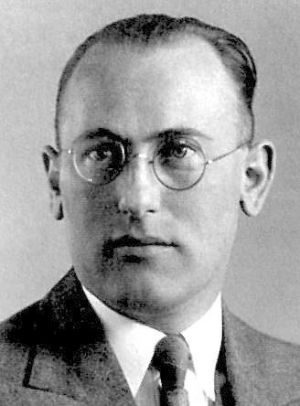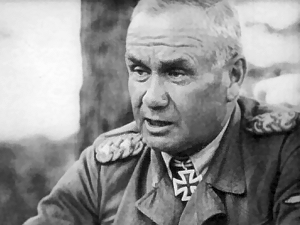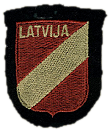Traitors, a constant of history
With three separate occupations during and after World War II, anyone who worked in any sort of municipal or administrative position, even in a continuation of their pre-war position, could be labeled a "collaborator". Indeed, at least one scholar has maintained that any cooperation with a victor by a citizen of a defeated state is "collaboration."1 We posit a more useful, quantifiable and verifiable, definition: "collaboration" is voluntary and traitorous cooperation against the interests of one's fellow citizens.
There will always be traitors. This is a simple fact. Americans have their Benedict Arnold. The French, Philippe Pétain. Christianity, perhaps the most infamous of them all, Judas Iscariot. Take the example from Latvian history of the Liv leader and contemporaneously described as "nearly king" Kaupo2:
He was the first prominent Livonian to be christened.3 He was probably baptized around 1191 by a priest called Theoderic. He became an ardent Christian and friend of Albert of Buxhoeveden, Bishop of Riga, who took him in 1203-1204 all the way to Rome and introduced him to Pope Innocent III. The Pope was impressed by the converted pagan chief and presented him a Bible. When he returned from travel, his tribe rebelled against him and Kaupo helped to conquer and destroy his own former Castle of Turaida in 1212. The castle was rebuilt two years later as a stone castle that is well preserved even today.4Kaupo participated in a crusader raid against the still pagan Estonians and was killed in the Battle of St. Matthew's Day in 1217 against the troops of the Estonian leader Lembitu of Lehola. He did not have any male heirs as his son Bertold had been killed 1210 in the Battle of Ümera against Estonians. He left his inheritance to the church, but the Lieven family later claimed female-line descent from him.5
Modern Estonians, Latvians, and the remaining few Livonians do not have consensus view about the historical role of Kaupo. Some consider him traitor and enemy agent. Others consider him a visionary leader who wanted his people to be part of Christian and European culture. Both these judgments attribute 19th-century views about nationality to a medieval chieftain. Latvian legends, however, are unequivocal: there he is named "Kaupo the accursed, the scourge of the Livs,... Kaupo who has sold his soul to the foreign bishops."6
The Holocaust
Having worn the uniform of the Nazi invaders/occupiers denotes no more allegiance than wearing that of the Soviet invaders/occupiers. Nor does it imply participation, active or passive, in the Holocaust. For their part, Legionnaires wore their loyalty under their uniform, a folded-up Latvian flag.
Sicherheitsdienst-subordinated killing squads
Contrary to baseless accusations that Latvians excuse the genocidal acts of collaborators (read "traitors") because they were eventually deployed on the Eastern front against the re-invading Soviets, those collaborators are far more "accursed" than Kaupo of legend, including being denounced by Legionnaires at the time.7
The invading German military enlisted collaborators upon invasion. Arājs Kommando, the most notorious of the Sicherheitsdienst (SD)-subordinated units, grew from under 50 after the first week to less than 100 during the first month of the occupation, to 300 at the height of the Holocaust in Latvia, while up to 1,200 as multiple squads in later "anti-partisan" action outside Latvia, primarily in Belarus.89
Contrary to contentions Latvians were already feverishly killing Jews before the Germans even arrived, there was no rush to enlist to collaborate in the Holocaust.10 Participants were slow to join until the Germans opened their wallets to pay them off — and allowed them to plunder vacant Jewish property; anti-Semitism was not required, only the willingness to be a Nazi hit-man.11 Collaborator units operated under direct command and constant supervision of the Germans. Members had to check their non-automatic weapons out in the morning and back in at end of day or risk being shot — machine guns were reserved for German killing squads. There was no independent "Germanless" action.

Police battalions at the front and the later Latvian Legion reported to the Wehrmacht, not the SS
 SS-Obergruppenführer Friedrich Jeckeln,
SS-Obergruppenführer Friedrich Jeckeln,implementer of the Holocaust in Latvia, photo at occupation.lv
Viktors Arājs's Sicherheitsdienst (SD) killing squad was one of several such units formed shortly after the occupation. Arājs's unit lasted most of the war. It was disbanded in mid 1944, with some members joining the Latvian Legion, others departing via a ship from Liepāja to Germany — including Arājs himself.
There, Arājs attended Wehrmacht officers' training and returned to briefly command a Latvian Legion unit — soon to be relieved from his position as unsuited. While he attempted to evade identification after the war under assumed names, he was betrayed to authorities by other Latvians more than once. British interest in employing him as a spy in Latvia after the war led to a series of circumstances which allowed him to again evade authorities after a warrant for his arrest was issued in 1949 in Germany. Arājs was eventually arrested in Stuttgart in mid-1975, indicted in 1976, and found guilty on December 21, 1979. He died in prison in 1988.12
As of January, 1943 archival records show a total of 1,190 Latvians in SD-subordinated units. Major deployments included: 154 fighting on the northern front, 284 in the Minsk region, 189 performing guard duties in Salaspils, and 338 stationed in Riga.13 As Arājs operated primarily in today's Belarus, the figure of 284 deployed around Minsk implies his unit must have been supplemented later in 1943 or that it was significantly smaller than indicated in other figures.
Sicherheitsdienst operatives at the Rīga prefecture
Much has been made of the Rīga prefecture, the city's central prison, being "run" by Latvians, that the Germans may have even been unaware of the atrocities committed there.14 In actuality, Walter Stahlecker's established the prefecture as his headquarters upon his arrival — the same day Nazi forces entered the city. This was the venue for Stahlecker's meeting with Arājs. Stahlecker installed Roberts Štiglics, a Latvian political police functionary under Ulmanis and whom he had brought with him from Germany, as prefect.15 Owing to timing, it is likely Štiglics led Latvian collaborator involvement in initial anti-Jewish actions in Rīga, not Arājs. (Indeed, Arājs's men were to later joke that Arājs himself was not much of a commander, that he was mainly responsible for bringing the booze to the action.)16.
It is important to note that pre-invasion Nazi plans for the eradication of central/eastern Europe's Jewry had not included local killing squads. The Nazis were forced to improvise when Latvians failed to "spontaneously" kill their fellow citizens. Indeed, their own reports documented their failure to foment anti-Semitic action in the local populace. 17 Ironically, the Nazis resorting to enlisting and paying collaborators demonstrates proof of their failure. However, this limited success in securing active collaborators is lost, "drowned", in the immensity of those collaborators' crimes.18 Arājs alone was ultimately convicted of killing 13,000 Jews, while Holocaust scholar Andrew Ezergailis estimates an actual number double that (26,000).19
Police battalions
The vast majority of police battalions did not collaborate; from the first days of the occupation, volunteers seeking to pursue the retreating Red Army were organized into battalions which served on the Eastern Front under the Wehrmacht. This recruiting reserve was run by Voldemārs Veiss with his adjutant, Vilis Hāzners.
Both SD units and combat units shared the generic description of "police battalion," therefore it is essential to examine the organizational affiliation, reporting structure, and record of any specific battalion to determine if it was culpable in the Holocaust.
It should be noted that Latvians who had believed they had volunteered for "protection" duties questioned their orders when it came to anti-Jewish actions20; clearly, it was not obvious to all who signed on for "guard" duty in the wake of the Soviet occupation that they may have signed on to be Holocaust collaborators. (Those police battalions which collaborated mainly performed guard duty.)
Regardless of how they came to their role, willingness, or motivations, directly and indirectly participating Latvian collaborators totaled some 3,000.
We recommend Prof. Andrew Ezergailis's seminal work on the Holocaust in Latvia as essential reading for anyone interested in learning about events in Nazi-occupied Latvia. We also recommend Prof. Ezergailis's web site for later materials and evolving perspectives based on subsequently available information, at holocaustinlatvia.org, originally at haolusa.org (Holocaust Archives of Latvia, USA).
Yet to be seriously studied is the role of returning Baltic Germans in managing the Holocaust for their Nazi masters.21 Hitler had arranged for the resettlement of Germans primarily to occupied Poland, allowing them to escape the first Soviet occupation.22
The denouement of Arājs Kommando
Some journalists and activists contend that once the Holocaust was over in Latvia (end of 1941), that when the Latvian Legion was created in 1943, former members of Arājs Kommando were incorporated — thus constituting its criminal core. This is false.
It was only as circumstances deteriorated late in the war that Arājs's unit was eventually disbanded and scattered, including redeployment into the Latvian Legion at the front. These were not welcome additions. Legionnaires considered them cowards who avoided combat.
The following documents what has been possible to determine regarding the disposition of Arājs's unit towards the end of the war.23
The end of the Kommando
By the middle of 1944 the Arājs commando had lost its usefulness and its demobilization began. By that time Arājs was in charge of only half of the unit. In the spring of the same year Arājs was in Riga, retaking some law examinations at the university. Professor A. Aizsilnieks met Arājs at the graduation banquet and asked him for advice about delivering a lecture on the radio, something the Germans had asked him to do. As we have seen, Arājs advised him not to cooperate: "With Germans it is thus, if they get hold of your finger, then the whole of you is lost, because soon enough one is forced to do things that one would never do if one could get out of it."
In mid-February Kr. Barona iela [street] 99 quarters were taken over by the Legion. Part of the commando was quartered in L. Kalnu iela 6 and another part sent to Susu muiža [manor].
In August 1944 the Ozols battalion was withdrawn from the front; he was ordered to retrain and reorganize his men along military lines. On September 20, Ozols was appointed to command the 2nd Battalion of the 2nd Border Guard Regiment, which in December was renamed the 106th Grenadier Infantry SS Regiment and transferred to the Legion. Capt. Arnolds Laukers, who since 1942 had been the commander of the Riga HQ, in September 1944 was ordered to Dundaga. On October 10, Laukers' group was ordered via Ventspils to Danzig, and quartered in Könitz. In November 15, the battalion was divided into groups of fifteen to twenty men and transferred to the Latvian Legion. Jānis Vanders, who deserted the commando before his company was sent to Germany, summed up the commando's dissolution thus: "Three companies of the Arājs commando entered the Legion. One company went to Germany, the second went to Liepāja, and the third to Ventspils." The company led by Arājs moved to Germany and was dissolved in October 1944, its membership divided among numerous units of the 15th Latvian SS Division. Teodors-Fricis Detlavs and Arnolds Trucis entered the 9th Company, 3rd Battalion of the 32nd Regiment.
Some smaller details of Arājs men worked in the SD until the very end. Another group lived on the razor's edge between collaboration and resistance. Many of them entered the meža kaķi (forest cats), who were to be parachuted behind lines and vowed to fight the Russians after capitulation. Others ended up fighting the national partisans, and took part in the suppression of the Kurelis group in the Kurzeme forests. To what degree the remnants of Arājs's commando fought the kurelieši (men of the Latvian national resistance) in 1944, has not as yet been fully clarified.
Legion hierarchy within a division: regiment (pulks), battalion (bataljons), company (rota), platoon (vads), unit (vienība), squad (pusvads).
That three companies (rotas) were transferred into the Legion indicates a relatively small number of men. Documentation we have of Latvian Legion companies indicates depleted sizes of around 100 men: officers, NCO's, and infantry, whereas a full Wehrmacht company consisted of 6 officers and 250 men. "Three companies" could range from 300–750 men. Holocaust scholar Andrew Ezergailis has concluded that approximately 600 of Arājs's men were redeployed into the Legion.
Legionnaires were not collaborators — Zuroff
Regardless, no one has been accused of crimes while in service of the Legion. Even Holocaust scholar and Nazi-hunter Efraim Zuroff has acknowledged (2012) that the Latvian Legion was not involved in the Holocaust. YouTube clip follows.24
| 1 | John A. Armstrong, "Collaborationism in World War II: The Integral Nationalist Variant in Eastern Europe", The Journal of Modern History, vol. 40, no. 3 (September 1968), pp. 396–410. |
| 2 | From the linked-to "Caupo of Turaida" Wikipedia article. |
| 3 | Heinrici Chronicon Livoniae, Henricus (de Lettis) ed., Olion, 1982, p.43. |
| 4 | DK, DK Eyewitness Travel Guide Estonia, Latvia & Lithuania, Dorling Kindersley Ltd, 2015, ISBN 978-02-41-23971-1, p.192. |
| 5 | Crusading and Chronicle Writing on the Medieval Baltic Frontier: A Companion to the Chronicle of Henry of Livonia, Ashgate Publishing, Ltd., 1 November 2011, ISBN: 978-0-7546-6627-1, accessed 14 August 2012. LINK |
| 6 | Urch, R.O.G. Latvia — Country and People. London: George Allen and Unwin Ltd. 1938. |
| 7 | Interview, Andrew Ezergailis. |
| 8, | Ezergailis, Andrew. The Holocaust in Latvia, 1941-1944: The Missing Center, Historical Institute of Latvia in association with the United States Holocaust Memorial Museum, 1996, ISBN: 9789984905433. LINK |
| 9 | All SD commanders in Latvia were Germans. |
| 11, | Conversation with Holocausts scholar Andrew Ezergailis, July, 2020. |
| 14 | "On July 7, less than a week after their arrival in the city, Einsatzgruppe A organized a pogrom in Riga and reported that four hundred Jews had been killed. As evidenced by photographs, the actual slaying was done by Latvians and not Germans. The Nazis described this outrage as a "self-cleansing" operation. In his report to SS Chief Heinrich Himmler, Dr. Stahlecker, the head of the group, stated that no other operation of that nature had taken place in his domain. Stahlecker must have been referring only to operations organized by the Germans. As it turned out, they did not have to make an extra effort, considering the conditions that normally prevailed at Riga's Central Prison, called Zentralka, a site of the most brutal murders, or at the Riga Police Prefecture, which was presided over by Roberts Stiglics." Gertrude Schneider. Journey into Terror: Story of the Riga Ghetto, New and Expanded Edition. This narrative comes from Soviet propaganda. Photographs were staged — there was no Germanless "self-cleansing." As indicated later, Štiglics arrived in Rīga with Stahlecker and reported to him. |
| 15 | In a declassified CIA document, Štiglics described his time during the Nazi occupation thusly: "In 1941 after the expulsion of communists I returned to Lettland, where I had been entrusted to form the Home Department. My task done, I was promoted to the rank of Sub-Colonel and appointed Lord Mayor of Riga. There being in my disposition and under my command the municipal, political and criminal police forces. This period of the Second World War was characterized by incessant communist partisan activities and lasted till October 1944." Štiglics's claim of "Lord Mayor" is false; the Nazis installed Hugo Wittrock for the duration of their occupation. Elsewhere, his employment history simply indicates "1919-1944 Latvian police", and notes that he "[h]ad some 2000 police and informers under him in Riga." Štiglics also apparently worked for the CIA until some time in 1950 under the cryptonym ALLEYCAT-14. |
| 17 | German reports to Berlin, entered in Nuremberg trial records, complained of Latvian "passivity" in the face of Nazi instigation. |
| 22 | Background on Hitler's "call home", per Kārlis Kangeris at genocid.lt: The reorganization of the ethnographical situation in Eastern Europe was described by Reichschancellor Adolf Hitler in a speech at the Reichstag October 6, 1939 as "a most important undertaking". Emigration, leaving one's habitat or, as propaganda would have it, "accepting the invitation of the Führer" or "the return home to the Reich" was one aspect of ethnic reorganization. The other aspect of this ethnic reorganization was finding a new place of abode for this "group of endangered German nationals", either in the German Reich or in newly annexed parts or else in occupied territories. With the departure of Baltic Germans from Estonia (18.10 – 15.11.1939) and Latvia (7.11. – 16.12.1939), the ethnic reorganization was begun: the mass displacement of inhabitants in Eastern Europe. These Baltic German "repatriants" were at first settled in the regions annexed from Poland October 12 (the former "Polish corridor" that Germany forfeited as a result of the Treaty of Versailles) that were now the Reich provinces Danzig-Westpreussen and Warthegau. In order to accommodate the Baltic Germans and compensate them for the material possessions left behind in Estonia and Latvia, Poles and Jews were displaced, their property and possessions confiscated and they themselves were taken to occupied regions of Poland — the General Government (from June 1940 onward). With increasing numbers of ethnic Germans (Volksdeutsche) arriving, increasing numbers of Poles and Jews had to be displaced thus creating growing problems for the technocrats in charge of displacement, encouraging them to seek more radical solutions, especially with respect to the future fate of the Jews. |
| 23 | Ezergailis, Andrew. The Holocaust in Latvia, 1996. p. 194-195. |
| 24 | First retrieved December 24, 2020. The video plays from the YouTube site. |
